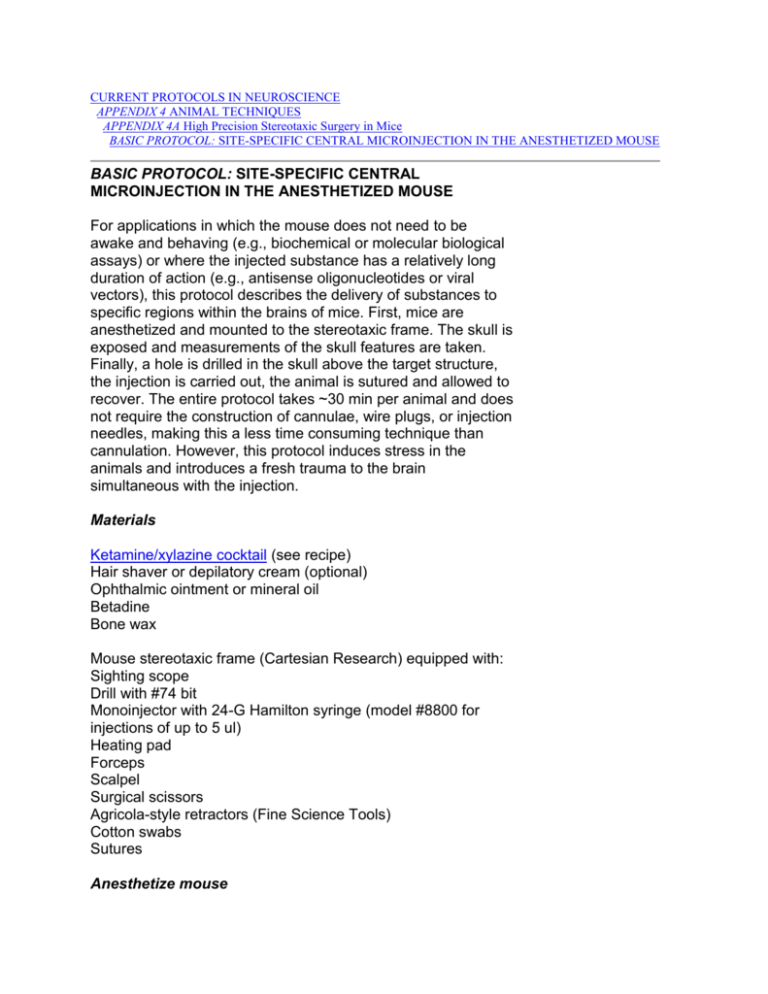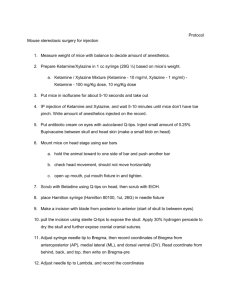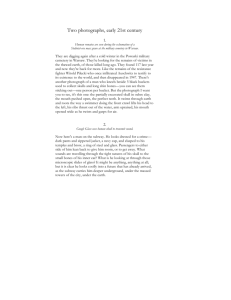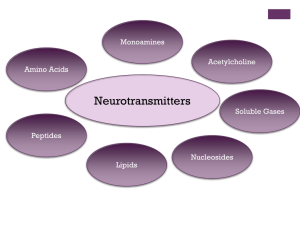
CURRENT PROTOCOLS IN NEUROSCIENCE
APPENDIX 4 ANIMAL TECHNIQUES
APPENDIX 4A High Precision Stereotaxic Surgery in Mice
BASIC PROTOCOL: SITE-SPECIFIC CENTRAL MICROINJECTION IN THE ANESTHETIZED MOUSE
BASIC PROTOCOL: SITE-SPECIFIC CENTRAL
MICROINJECTION IN THE ANESTHETIZED MOUSE
For applications in which the mouse does not need to be
awake and behaving (e.g., biochemical or molecular biological
assays) or where the injected substance has a relatively long
duration of action (e.g., antisense oligonucleotides or viral
vectors), this protocol describes the delivery of substances to
specific regions within the brains of mice. First, mice are
anesthetized and mounted to the stereotaxic frame. The skull is
exposed and measurements of the skull features are taken.
Finally, a hole is drilled in the skull above the target structure,
the injection is carried out, the animal is sutured and allowed to
recover. The entire protocol takes ~30 min per animal and does
not require the construction of cannulae, wire plugs, or injection
needles, making this a less time consuming technique than
cannulation. However, this protocol induces stress in the
animals and introduces a fresh trauma to the brain
simultaneous with the injection.
Materials
Ketamine/xylazine cocktail (see recipe)
Hair shaver or depilatory cream (optional)
Ophthalmic ointment or mineral oil
Betadine
Bone wax
Mouse stereotaxic frame (Cartesian Research) equipped with:
Sighting scope
Drill with #74 bit
Monoinjector with 24-G Hamilton syringe (model #8800 for
injections of up to 5 ul)
Heating pad
Forceps
Scalpel
Surgical scissors
Agricola-style retractors (Fine Science Tools)
Cotton swabs
Sutures
Anesthetize mouse
1. Anesthetize the mouse with an intraperitoneal injection of an
appropriate dose of ketamine/xylazine cocktail. After the animal
has reached full anesthesia, remove the fur from the top of the
skull with a shaver or depilatory cream or by plucking with
fingertips or a pair of forceps.
A dose of ~20 ul/g body weight is generally appropriate,
however, mice of different strains, ages, and adiposities will
have differing sensitivities to the anesthetic. The total volume of
the injection should be limited to 750 ul to prevent discomfort to
the animals. For large or obese mouse strains, this may require
that the concentration of the anesthetic be increased to permit
smaller volume injections. The correct level of anesthesia has
been reached when the mouse shows no palpebral or tail-pinch
reflexes, generally within ~5 min of the injection. A surgical
level of anesthesia should persist for 45 min to 1 hr.
Mount mouse to stereotaxic frame
2. Swing the nose clamp and incisor bar down and out of the
way, and then lock one of the ear bars at ~3.5 mm from center.
Set a heating pad on low (~35C) and place it on the
stereotaxic frame to maintain body temperature and raise the
animal to the level of the ear bars. While supporting the
animal's head from beneath, guide the tip of the locked ear bar
into the external auditory meatus and hold firmly. Slide the
other ear bar into the opposite ear and apply steadily
increasing pressure until small popping sounds are heard; this
popping indicates that the ear bars are properly inserted to the
tympanic membranes.
The animals will show some hearing loss immediately after the
surgery, but hearing seems normal after one week of postoperative recovery. For experiments where normal hearing is
critical, non-rupture ear bars may be preferred. However, the
head will not be held as stably with this style of ear bar, and the
accuracy and precision of the surgery may suffer as a result.
If mounting an adult mouse and the total distance between the
ear bars is <5 mm, it is very likely that the ear bars are not in
their proper place within the sockets. Also, if gentle lateral
pressure moves the snout >2 mm in either direction, ensure
that the ear bars are properly seated within the sockets and
apply more pressure.
3. Swing the incisor bar up and slide it just into the mouth while
holding the jaw open with a pair of blunt forceps. Apply
downward pressure to the bridge of the nose while sliding the
incisor bar back into the mouth. Stop when the incisors drop
into the hole in the bar. Swing the nose clamp into position on
the bridge of the nose and tighten firmly. Optionally apply
ophthalmic ointment or mineral oil to the eyes to keep them
from drying out and protect them from accidental spills.
Perform surgery and injection
4. Disinfect the scalp with Betadine and make an incision along
the midline with a scalpel. Using surgical scissors, extend this
incision forward to the back of the eyes and backward to
between the ears. Use caution to avoid damaging the muscles
that insert on the external occipital crest on the back of the
skull. Set Agricola-style retractors in the incision to expose the
skull, and scrape away the transparent pericranial tissues with
a cotton swab.
5. Fit the monoinjector to the stereotaxic frame and take DV
measurements at bregma and lambda by lowering the tip of the
injection needle until it is just touching these structures. Raise
or lower the incisor bar/nose clamp to bring the bregma and
lambda DV coordinates within 0.1 mm of each other. Zero the
DV scale at bregma (see Fig. 3.10.1). Fit the sighting scope to
the stereotaxic frame, align the crosshairs with bregma and
zero the AP and ML scales.
6. Fit the drill to the stereotaxic frame, set it at the target AP
and ML coordinates and drill a hole through the skull at a rate
of ~25 to 50 um/sec.
The diameter of the hold will depend upon the size of the
cannula or monoinjector needle used. If a 24-G cannula or
monoinjector needle is used, then a diameter of ~0.57 mm
works well. As a general rule, the depth of the hole should be
~200 um from the surface of the skull. However, the thickness
of the skull varies and, depending on the stereotaxic
coordinates being utilized, the depth may have to be adjusted
to ensure that the hole is completely through the skull while
minimizing damage to the brain.
More accurate injections can be achieved by using a correction
factor for determining the target coordinates. To get this
correction factor, divide the bregma-to-lambda distance of each
animal by the bregma-to-lambda distance from a stereotaxic
atlas. Multiply the coordinates given by the atlas by this number
to determine the corrected coordinates.
7. Fit the monoinjector to the stereotaxic frame. Lower the
needle into the hole to the target DV coordinate and inject.
Leave the injection needle in place for at least 30 sec after
completion of the injection and before removal of the needle.
Injections directly into brain tissue should not be applied at >0.5
ul/min, however, intracerebroventricular injections can be
carried out a faster rate (1 um/min).
8. Remove the monoinjector and seal the hole with bone wax.
Suture the incision and remove the animal from the stereotaxic
frame. Keep the animal warm during recovery by placing its
cage on a heating pad set on low (~35C). House animals
individually until the incision has healed to prevent them from
chewing each other's stitches.
From Current Protocols in Neuroscience Online
Copyright © 2003 John Wiley & Sons, Inc. All rights reserved.








